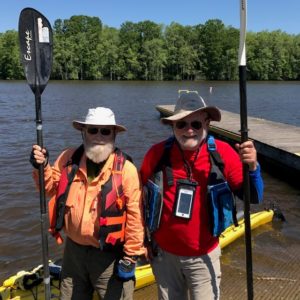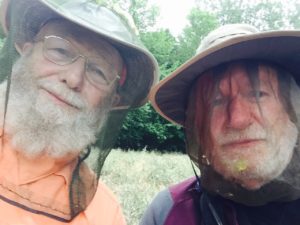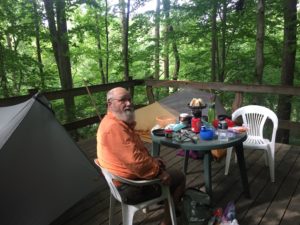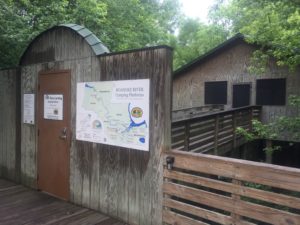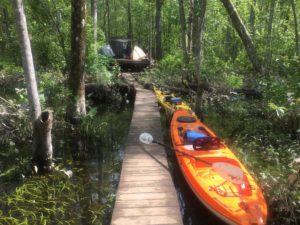Before someone gets the wrong idea from this post I should say this: I’m glad I paddled the Neuse River last year.

I had a terrific partner, Mike Johnson of Franklin, N.C.; we met two wonderful river angels, Bill Hines of Oriental and Ronda Hughes of Seven Springs, N.C. I learned some things. It was interesting. I might do it again someday.
OK, that said:
I was surprised at how much my 225-mile trip down the Neuse was like hiking the Appalachian Trial from Georgia to Maine.
In one major way, however, it was unlike the hike — I was not certain I could make it to the end. On the thru-hike I had no doubt, ever, that I would finish, assuming I wasn’t killed, injured, or got sick. Or had to go home to take care of an emergency.
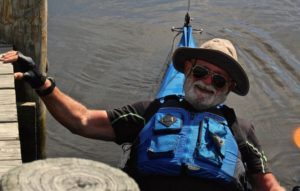
I had my doubts about finishing the river trip when I woke up on the morning of what was the eighth and final day because I knew we’d have to battle wind and rough water.
But, first, the similarities:
• I was tired at night, exhausted is more like it.
I thought Mike, a retired Navy commander, and I were going to more or less float down the Neuse. But to make the miles we wanted to make, to get to the spots where we wanted to camp, I had to paddle almost constantly. We averaged almost 30 miles a day, with a top day of 36.5 miles. My sit-on-top kayak, a Hurricane Skimmer, was part of the problem. I bought it to dink around in Stump Sound, near Topsail Island on the coast, and for that it’s perfect. But paddling it down the Neuse, trying to make miles, was like paddling a bathtub — I had work it it.
• I blistered.
On the Appalachian Trail the sides of my heels blistered when I failed to replace my worn out boots quickly enough. On the river, my feet were fine, of course. But the rest of me blistered even though I applied lots of sun screen and wore a wide brim hat. It was 90-plus degrees most days with little or no cloud clover and no shade. I fried, even my lower lip.
• I had little appetite.
If I couldn’t get to a restaurant I didn’t eat much of anything. I was the same way during the first few weeks on the trail.
• The best part of the day was the end of the day.
When I hiked all day, up, down, up, down, I really looked forward to getting where I was going. I felt the same way after I had paddled all day.
- And, yes, just like the trail, I lost stuff.
I lost so much stuff on my thru-hike I stopped blogging about it. It was embarrassing. On the river trip I lost a knife scabbard, no big deal. But when we got to Oriental and began going through our gear, loading my kayak on Brother Dave’s truck, I couldn’t find my cell phone. Bill Hines called Blackbeard Sailing Club, where we camped the night before, and asked if anyone had found and turned in a cell phone.
No luck.
There was the slimmest of possibilities that I had left my phone at the spot where I had pitched my tent. [I live in hope.] So Dave stopped by Blackbeard on the way back home, to Knightdale, N.C., and there it was, laying in the grass.
- Like the trail, the river has angels too, and I met two — Hines and Ronda Hughes. Ronda fed us and let us shower at her home and camp in her back yard; Bill loan us sea kayaks and got us through the waves to Oriental.
- Brother Dave drove to Maine to pick me up when I finished my thru-hike and when Mike and I got to Oriental, there he was.
Like the A.T., the second half of the Neuse is a lot more difficult.
Near its headwaters at Falls of the Neuse the river isn’t much bigger than a good size creek. For the first 100 miles or so, as the Neuse gradually widens and deepens, you run into a lot of obstructions, strainers, they’re called. They let the water go by, but they don’t let you go by. Countless trees have fallen into the river. Some limbs are sticking out, some are just beneath the surface. They are not a big problem but you have to stay awake.
A few miles before you get to New Bern the Neuse begins to widen dramatically. It’s a mile wide at New Bern. It looks like the ocean, with waves and white caps if the wind is up. From New Bern on it gets wider and wider, about two and a half or three miles wide by the time we reached our destination, Oriental.
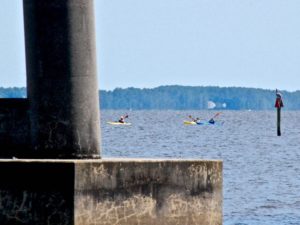
Bill, Mike, and I camped the last night at the Blackbeard Sailing Club and when I woke up I was not sure I could make it to Oriental. Paddling in what amounts to the ocean is nothing like padding in a river. There is no current to help you. And for part of the way Bill expected that we would have to paddle into the wind and waves. He was right.
It was not an easy day for me or Mike, but doable, thanks to Hines.
Coming Monday: An Out Of Body Experience
